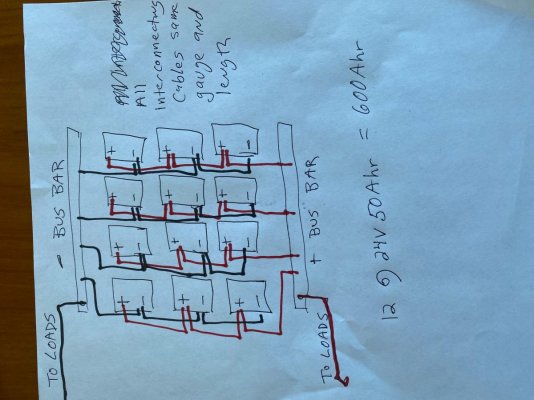Twisted tree, thanks you pretty much confirmed what I had previously been led to believe. I contacted battleborn technical support and they said their “drop in” LFP batteries are top balancing so they should be charged to 100% every few weeks to allow any cell imbalances to be equalized. I like your comment on setting the float voltage at 70% SOC voltage for long term storage. Do you think this approach is preferable over having the charger go into silent mode and rebulk at a set voltage? While on shore power I bounce between 100% to 30% over a 3 day period.
Some batteries, Battleborn being one of them I think, only activate their balancing circuits while the batteries are at or near full charge. So if you never fully charge them, they will never balance. This is why it's always important to follow any specific directions from the battery manufacturer.
Regarding float, I think some early guidance was misinterpreted and the whole thing skipped the rails and took on a life of it's own. Unwinding it is now a very difficult task.
It really comes down to what you mean by a "float charge". With lead, it's an elevated charge voltage that causes a continuous, ongoing charge current. You definitely don't want to do that with LFP. Once they are charged, you need to stop applying current. This led to a "don't float LFP" Mantra, without really understanding that it's more specifically a continuous charger current that's bad.
With that Mantra, people just disabled the float feature in their chargers, leading to what I believe is gratuitous and wasteful cycling of your batteries. People do exactly as you have which is to charge to full, then shut off the charger and run on the batteries until they drop to some low level, then recharge the again to full.
This is particularly wasteful when you are charging with solar. When the sun comes up, your batteries start charging and let's say they are full by 14:00. If you just stop charging, then all your afternoon loads drain the batteries even though you have solar power right there for the taking. Then when morning comes around again, you have not only drained the batteries with your night loads, but also the afternoon loads from the previous day. And the same is true if you are on dock power. Why cycle your batteries when dock power is continuously available.
If instead you make use of the float function in your chargers, it solves multiple problems. First, set the flat voltage so it doesn't create a continuous charge current when the batteries are full since we know that's bad. Instead set the float voltage to match the battery's resting voltage somewhere in the 50-80% SOC range. Note that because in this range then resting voltage of LFP is pretty flat across a wide SOC range, this will NOT be a precise setting. What's important is that it's below about 80% if you expect to leave the batteries on the charger for an extended period of time. That solves the long-term storage issue.
Now what happens is your charger initially does a full charge cycle and brings the batteries to 100%. Then it switches to float, which is less than the battery's resting voltage. In this situation, the charger doesn't deliver any current, and the loads run completely off the batteries. At this point it's just like turning the charger off completely. However the charger is on and waiting for the battery SOC to drop to the point where the battery voltage matches the charger's float voltage. When the voltages match, the charger starts to pickup to loads rather than the batteries, and it all settles out in an equilibrium where the batteries are held at a reduced SOC rather than cycling, and the charger is carrying the loads. This system can stay like this indefinitely.
The only down side is that if you unplug and motor away, you are getting underway with less than 100% SOC. But as you are motoring, you will also (presumably) be charging the batteries back towards 100% SOC, ideally reaching it before you drop the anchor for a nice quiet night. So I think it actually all works out pretty well.


